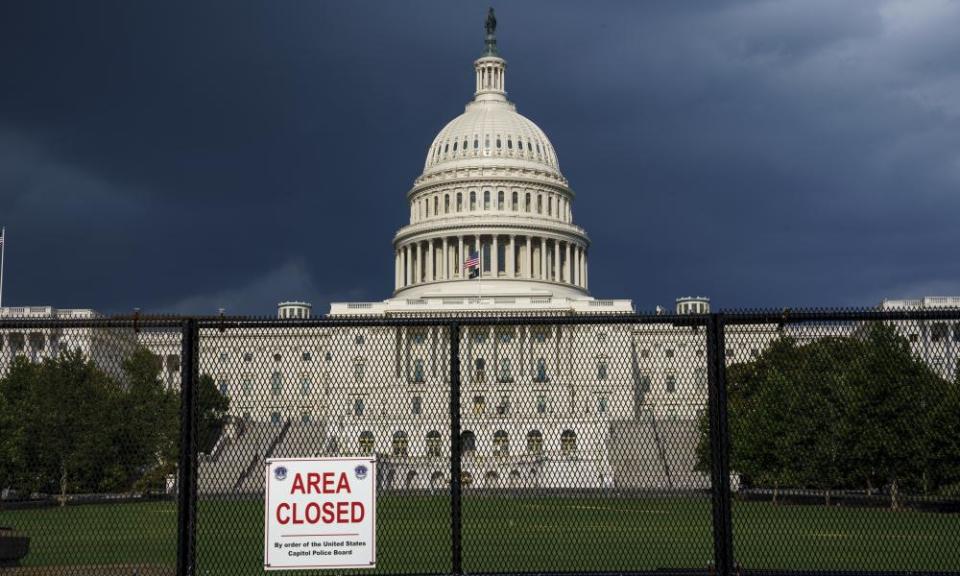White House unveils first national strategy to fight domestic terrorism

The White House has published its first ever national strategy for countering domestic terrorism five months after a violent mob stormed the US Capitol in Washington.
The framework released on Tuesday by the National Security Council describes the threat as now more serious than potential attacks from overseas but emphasises the need to protect civil liberties.
Anticipating Republican objections that Joe Biden could use counterterrorism tools to persecute supporters of Donald Trump, the strategy is also careful to state that domestic terrorism must be tackled in an “ideologically neutral” manner.
Related: FBI chief calls Capitol attack domestic terrorism and rejects Trump’s fraud claims
It cites examples such as “an anti-authority extremist” ambushing, shooting and killing five police officers in Dallas In 2016; a lone gunman (and leftwing activist) wounding four people at a congressional baseball practice in 2017; and an “unprecedented attack” on Congress on 6 January 2021.
“They come across the political spectrum,” a senior administration said on a media conference call. “We acknowledge the shooting at the congressional baseball, the attack on police officers in Dallas, just as we acknowledge the attack in Charlottesville and the attack on the Capitol on January 6.
“So it’s not motivating politics or ideology that matters for us or, more importantly for the strategy and its implementation. It’s when political grievances become acts of violence and we remain laser focused on that.”
The strategy, to be formally announced by attorney general Merrick Garland on Tuesday, follows an order from Biden on his first full day in office for a review of government efforts to address domestic terrorism, which is described as “the most urgent terrorism threat the United States faces today”.
An expert assessment of the threat provided by intelligence and law enforcement, a summary of which was released in March, found that its two most deadly elements are white supremacists and anti-government violent extremists.
A senior administration said: “Further, it found that violent extremists who promote the superiority of the white race have the most persistent transnational connections and may be in frequent contact with violent extremists abroad.
“However, it’s important to underscore that the study provided to us by ODNI [Office of the Director of National Intelligence] did not find a robust nexus between domestic terrorism and foreign actors. This is largely today an inside-out problem, not an outside-in problem, although we do know that our adversaries are seeking to sow divisions in our society.”

The strategy consists of four pillars: efforts to understand and share information regarding the full range of domestic terrorism threats; efforts to prevent domestic terrorists from successfully recruiting, inciting, and mobilising Americans to violence; efforts to deter and disrupt domestic terrorist activity before it yields violence; long–term issues that contribute to domestic terrorism that must be addressed to ensure that this threat diminishes over generations.
The prevention aspect includes a focus on working with big tech companies such as Facebook, which has been strongly criticised for allowing rightwing hate groups to thrive and coordinate, including ahead of the 6 January insurrection.
An official said: “We as the government see different things from what any particular tech company might see, Any particular tech company often knows its own platform very well but the government sees things such as threats of violence across platforms... The process has already begun between the government and the tech sector and it will continue.”
Biden’s budget for fiscal year 2022 includes more than $100m in additional resources for analysts, investigators, prosecutors, and other personnel and resources to thwart domestic terrorism.
The government says it is improving employee screening to enhance methods for identifying domestic terrorists who might pose “insider threats”. The defence, justice and homeland security departments are pursuing efforts “to ensure domestic terrorists are not employed within our military or law enforcement ranks and improve screening and vetting processes”.
The strategy does not take a position on whether there should be a new statute criminalising domestic terrorism, leaving the question to a review by the justice department.
Despite its plea for neutrality, a White House fact sheet does cite key Biden legislation – the American Rescue Plan, American Jobs Plan and American Families Plan – as providing “relief and opportunity” that can help counter long term distrust in democracy and its ability to deliver.
It adds: “Government will also work to find ways to counter the polarization often fueled by disinformation, misinformation, and dangerous conspiracy theories online, supporting an information environment that fosters healthy democratic discourse.”

 Yahoo Finance
Yahoo Finance 